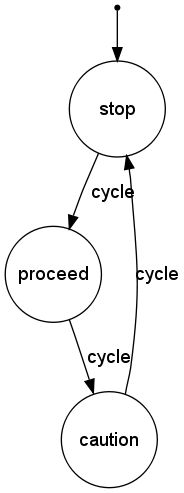强大的有限状态机 - state_machine
在推荐Ruby on Rails给做企业应用的朋友时候,比较常见的问题有"Ruby有没有好用的开源工作流引擎?",基于有限状态机(
Finite State Machine - FSM)构建工作流引擎是经常使用的实现方法,写篇短文介绍一下Ruby世界里的有限状态机:
首先列几个开源的Ruby FSM项目:
其中第一个项目state_machine是作者经过 2年半时间陆续开发的,特性比较完整,而且最近开发也比较活跃,下面简单介绍一下它的强大功能:
1. 基础用法:
我们来看一下它提供的一个红绿灯的例子
 得益于Ruby语言的优秀特性,state_machine定义了一套简洁DSL,使得代码非常易懂/易维护:
得益于Ruby语言的优秀特性,state_machine定义了一套简洁DSL,使得代码非常易懂/易维护:
使用这个红绿灯的代码:
2. transition hook:
利用state_machine提供的before/after transition hook机制,我们可以简洁地实现很多需求,比如订单状态改变的时候,我们需要记录一下:
也可以有选择性地在某些关键状态改变时做些动作:
3. 和ORM集成:
和Rails的ActiveRecord集成是很简单的一件事情,简单到你什么都不需要做,直接在Model文件里面定义就可以了:
然后在数据库里面添加一个栏位叫state,这样就可以持久化了:
结合它默认设置的scope,我们就可以写出这样简洁而又符合自然语法的代码:
和DataMapper / Sequel集成也是很简单,都是直接在Model文件里面定义,然后数据库添加栏位,而不需要额外的工作。
简单介绍到此,state_machine还有更多强大的功能不是这篇短文能够覆盖的,大家有兴趣的可以看它的文档和源代码。
最后值得提一下的是,这个项目总共只有1200行不到的代码,和动辄超过万行的Java workflow engine相比,学习起来是很轻松愉快的。
首先列几个开源的Ruby FSM项目:
其中第一个项目state_machine是作者经过 2年半时间陆续开发的,特性比较完整,而且最近开发也比较活跃,下面简单介绍一下它的强大功能:
- 可以在任意的Ruby类里面定义多个状态机
- 基于属性的event transitions
- 提供了和ActiveRecord / DataMapper / Sequel等多个ORM的集成
- 提供了before/after transition hook以方便于集成
- 状态驱动的instance/class行为
- 基于GraphViz的创建状态机图片
- ...
1. 基础用法:
我们来看一下它提供的一个红绿灯的例子
 得益于Ruby语言的优秀特性,state_machine定义了一套简洁DSL,使得代码非常易懂/易维护:
得益于Ruby语言的优秀特性,state_machine定义了一套简洁DSL,使得代码非常易懂/易维护:
- class TrafficLight
- state_machine :initial => :stop do #定义初始状态为stop
- event :cycle do #定义cycle事件,让状态从stop到proceed到caution到stop进行改变
- transition :stop => :proceed, :proceed => :caution, :caution => :stop
- end
- end
- end
使用这个红绿灯的代码:
- light = TrafficLight.new
- p light.state
- 6.times do
- light.cycle
- p light.state
- end
2. transition hook:
利用state_machine提供的before/after transition hook机制,我们可以简洁地实现很多需求,比如订单状态改变的时候,我们需要记录一下:
- class Order
- state_machine :initial => :pending
- before_transition :log_state_change
- #...
- end
- def log_state_change(transition)
- event, from, to = transition.event, transition.from_name, transition.to_name
- puts("Order #{number}: #{from} => #{to} on #{event}")
- end
- end
也可以有选择性地在某些关键状态改变时做些动作:
- after_transition :pending => :completed, :pending => :closed do
- #send email to order owner
- end
3. 和ORM集成:
和Rails的ActiveRecord集成是很简单的一件事情,简单到你什么都不需要做,直接在Model文件里面定义就可以了:
- class Order < ActiveRecord::Base
- state_machine :initial => :pending do
- event :confirm do
- #...
- end
- end
- end
然后在数据库里面添加一个栏位叫state,这样就可以持久化了:
- order = Order.create(...)
- p order.state # pending
结合它默认设置的scope,我们就可以写出这样简洁而又符合自然语法的代码:
- #找出所有状态为pending的订单,一一进行确认
- Order.with_state(:pending).all.each{|order| order.confirm}
和DataMapper / Sequel集成也是很简单,都是直接在Model文件里面定义,然后数据库添加栏位,而不需要额外的工作。
简单介绍到此,state_machine还有更多强大的功能不是这篇短文能够覆盖的,大家有兴趣的可以看它的文档和源代码。
最后值得提一下的是,这个项目总共只有1200行不到的代码,和动辄超过万行的Java workflow engine相比,学习起来是很轻松愉快的。